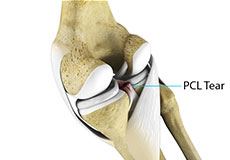
Posterior cruciate ligament (PCL), one of four major ligaments of the knee, is situated at the back of the knee. It connects the thighbone (femur) to the shinbone (tibia). The PCL limits the backward movement of the shinbone. The posterior cruciate ligament is usually injured by a direct impact, such as a motor vehicle accident when the knee forcefully strikes against the dashboard or during sports participation when a twisting injury or overextension of the knee can also cause PCL injury.
Injuries to the PCL are graded based on the severity of injury. In grade I the ligament is mildly damaged and slightly stretched, but the knee joint is stable. In grade II there is a partial tear of the ligament. In grade III there is a complete tear of the ligament and the ligament is divided into two halves making the knee joint unstable. Such injuries can result in instability in the knee joint, knee stiffness that causes limping, and difficulty in walking.
Diagnosis of a PCL injury is made on the basis of symptoms, medical history, and physical examination of the knee. The doctor may order a few diagnostic tests such as X-rays and MRI scan. X-rays are useful to rule out avulsion fractures where the PCL tears off a piece of bone with it. An MRI scan is done for better visualisation of the soft tissues. PCL injuries are very rare and difficult to detect when compared to other knee ligament injuries.
Generally, surgery is considered in patients with a dislocated knee and multiple ligament injuries, including the PCL.





